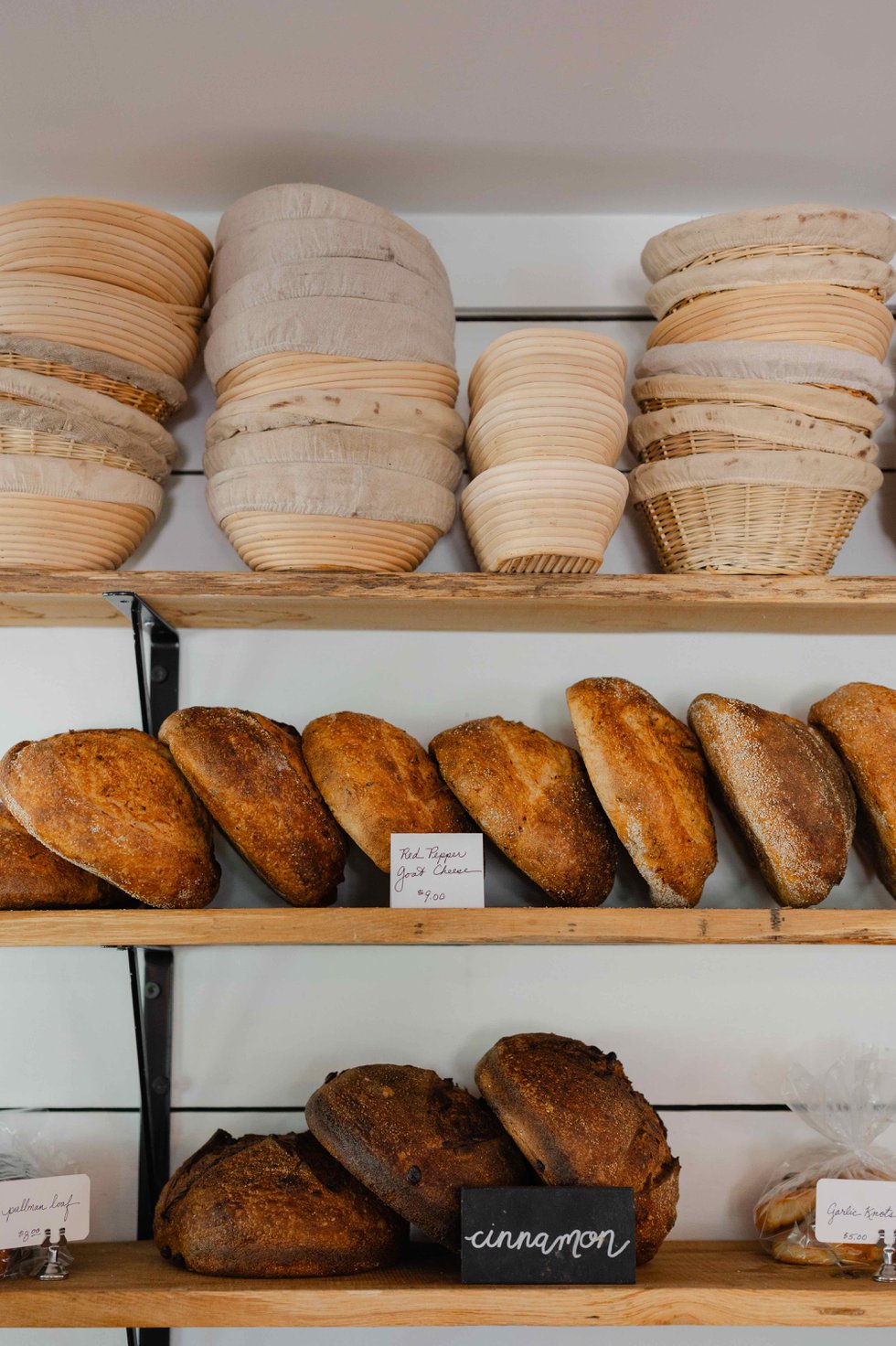Seasons’ Yield is in the milling business, and grinding flour and grains onsite is what helps create extra-special baked goods that get snatched up every other Saturday at Bread Day. Folks in the know can’t get enough.
Customers from all over flock to buy their $8.50 loaves—nearly four times the average cost of a loaf. But the Shears—the husband and wife team behind Seasons’ Yield—can barely keep up with demand. They say their secret is simple: stone-milled flour. This detail is all-important because it’s the flour that makes the bread. And it’s that picturesque mill that makes the flour—and, more so than pricey small-batch loaves, it’s milling that’s becoming the food trend.
On Bread Day, themes like wood-fired pizza or whole-hog barbecue direct the customer experience along a culinary trajectory. And the event regularly sees more than a thousand visitors—in rain, sleet, and snow—with loaves flying off the shelves.

Owners Daniel and Fawn Shear are flour fanatics. Ask Daniel what the difference is between store-bought flour and Seasons’ Yield flour, and he gives an audible sigh. “Phew. That’s a loaded question,” he says, choosing his words carefully. “If you’re comparing any flour off the shelf from the store and fresh-milled wheat, there is no comparison. You’ll have a loaf of bread at the end, but the things that come to mind when you look at the loaf, the texture and character of the loaf are so much richer.” It’s difficult to qualify, but there’s a darker color, and, he says, “the smell seems to hit you sideways. You note the smell: it’s more earthy. It’s deeper.”
Any bread aficionado will tell you the same thing, which may be precisely why big bakeries like Arnold and Pepperidge Farm have ferociously developed multigrain varieties, with grocery store shelves brimming with their nine-, 12-, and 15-grain loaves. Arnold’s new “Organic 22 Grains and Seeds” includes a tagline indicating that it’s “sustainably baked with wind energy.” But no matter how many grains they bake with wind energy, they’ll never stack up to bread made with fresh-milled flour.
The bread at Seasons’ Yield is astonishing. More than worth the drive is a potato rosemary sourdough—fluffy, moist, air bubbles perfectly enclosed within the crust, with an aroma that intoxicates and delicious chunks of soft potato scattered through the stretchy crumb.
If There’s a Mill, There’s a Way
A mill is comprised of a runner stone that spins above a stationary bed stone, and the surface is divided by furrows, or deep grooves, that are surrounded by lands, or flat areas. Smaller grooves called feathering or cracking spread away from the furrows and provide a cutting edge that directs the ground flour out through channels.
The repeating patterns created by the lands and furrows are called harps, and a typical millstone will have six, eight, or ten harps repeated on the face of each stone. When they are laid face-to-face, the patterns mesh, crushing what’s in between. Stones periodically need to be recut—which is called dressing—to keep the surfaces sharp.
The stones are positioned to crack the grain at exactly the right width without touching, separating the hard, fibrous protective shell called bran and the oil-rich germ from the wheatberry, leaving behind the endosperm, which is what’s ground into flour. The roller mill works differently: it separates the bran from the germ completely, keeping more of the bran and the germ, which means more flavor. Unfortunately—for our collective culinary history, our sense of place, and our health—the oil in the germ means that stone-milled flour will spoil, while roller-milled flour is shelf-stable. So for many reasons—among them economy of scale, efficiency, and profit—this is why stone milling is an uphill battle.

Yet at Seasons’ Yield, in the little building called the Milling Barn, where preordered loaves are lined up in paper bags, Daniel and Fawn preserve this link to the past in a time when sprawling, water-powered mills were the epicenters of villages and hamlets everywhere in America.
There’s a compact modern mill at Seasons’ Yield made by the New American Stone Company in Elmore, Vermont, which uses locally quarried granite for its mill stones. And at 26 inches in diameter, those mill stones are no small thing. But when you think of it next to a three story building with a water wheel, it seems like a Cuisinart. And it’s possibly just as revolutionary.
We Are the Millers
While deployed in Afghanistan, Daniel Shear read Chad Robertson’s Tartine, about how the California-based company started selling their to-die-for loaves. The bakery appeared in San Francisco’s Mission District in 2002 and soon went global. Now, with nearly a dozen locations in the Bay Area and around L.A., as well as in Seoul, South Korea, everyone who knows bread knows Tartine.
But it wasn’t actually the bread that grabbed ahold of him. It was the fact that Chad Robertson had taken his love for baking, his pursuit of the perfect loaf, and had built it into a business. “It really hadn’t occurred to me that that was possible,” Daniel says. “The book showed me what it would look like to follow our passion.”
So he and Fawn puzzled it out. They decided they wanted to work together, as a family, and to live off the land. They ran a CSA first, bringing vegetables and meat to farmers markets. The bread started as an add-on. Quickly it became what customers asked for. “Nobody was asking for more carrots,” says Daniel.

Today, the whole Shear family lives at Seasons’ Yield, including both Fawn and Daniel’s parents. Daniel feels that everyone is pulling their weight in the same direction. He says this collective effort creates “an environment where togetherness and community are valued.”
They so value community, in fact, that anyone can get a peek at the milling lifestyle: guests of their Bread Barn Airbnb get delicious whiffs of baking bread, minus all the grinding work. Outfitted in a Joanna Gaines meets Etsy style, the Bread Barn accommodations are supremely comfortable, stylish, and reasonably priced. Their “farm stays” are where guests can experience the “rhythms” of farm life nestled in the highly picturesque Blue Ridge Mountains. Not surprisingly, it’s consistently booked and well-reviewed, with most guests raving about—surprise!—that intoxicating aroma of baking bread.
Baking a Life
The Milling Barn, the Bread Barn, the beautifully tricked-out Airbnb, and the little children catching butterflies in the meadow are all charming aspects of Seasons’ Yield. But at its heart is what the Shears set out to create all along: a community brimming with talented artisans, engaging people, and nourishing, delicious food.
Daniel Shear says that the intangible side of nourishment explains why milling grain and baking bread is enjoying such popularity. “Crafting something by hand adds meaning and fulfillment to each bite,” he says. “I really enjoy baking with my children and working on the bread as a project to tackle and enjoy, and to learn about each other through the process.” For him, bread is like life: “you can only appreciate it and enjoy it if you make it for yourself.”
Max Watman is a former columnist for the Daily Beast and the New York Sun, and the author of the food memoir Harvest, among other books. He lives and writes on an old farm in Powhatan.









